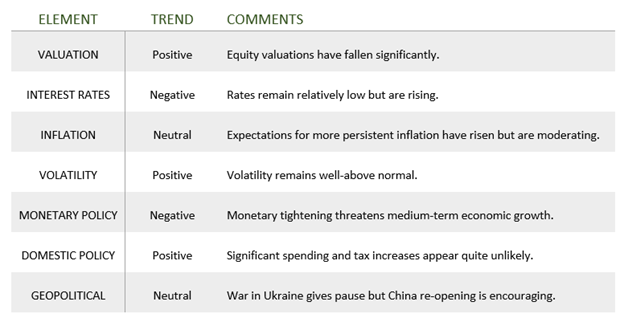June 30 2022

“If you are shopping for common stocks, choose them the way you would buy groceries, not the way you would buy perfume.” — Benjamin Graham
Financial markets just turned in the worst first-half performance in decades, with the S&P 500 now down 20 percent for the year on a total return basis. That’s the worst performance to start the year since 1970. For the month of June, the S&P 500 was down 8.3 percent, the Dow Jones Industrial Average was down 6.5 percent and the growth-heavy NASDAQ fell 8.7 percent.
The six-month report card was grim. Joining the S&P 500 in remedial math this summer will be the Dow, down 14.4 percent, and the NASDAQ, down 29.2 percent. After several flirtations this year, the S&P 500 officially entered a bear market on June 13, closing more than 20 percent down from its January peak, the first time the U.S. stock index closed in bear market territory since the COVID-19 abyss of March 2020.
While markets have long since ceased being fixated by C OVID-19 cases and death tolls, markets are still very much wrestling with the aftereffects of the pandemic. Supply chains continue to be disrupted by shutdowns in China, while government stimulus around the world, combined with strong employment, has helped keep demand elevated. Finally, the war in Ukraine’s impact on energy prices has been real, contributing to higher price expectations throughout the global economy. Ten-year interest rates in the U.S. have more than doubled since the start of the year.
There’s been a lot of ink spilled about the effect that interest rates have on asset prices, but it’s perhaps worth repeating anyway. As interest rates rise, the biggest price impact is on long duration assets such as long-dated bonds and expensive growth stocks—both are assets that are expected to pay back investors in the distant future. Those future returns are worth relatively less in a higher interest rate environment because they’re discounted back to the present at those higher rates. This is why growth stocks and long bonds have seen such significant price declines in the market this year, far more than short-term bonds and short-duration stocks such as big dividend payers and high earners. (The Russell 2000 Growth Index is now down 29.5 percent year to date, while the Russell 2000 Value is down 17.4 percent.)
However, while market prices continued to slide in June, the nature of the price action seemed to change. Not only had value beaten growth by almost 1600 basis points year to date, but value had outpaced growth every individual month also. That reversed in June, with growth outstripping value by 358 basis points. Of course, one month does not necessarily a trend make, but it did end value’s winning streak. What does this mean? It might be nothing at all, but it might be some evidence that tighter financial conditions are beginning to slow the actual economy, not just the financial markets, which often bodes well for growth stocks, which become more sought-after. Just like that, ten-year yields have come back in from almost 3.5 percent to below 3 percent. Consumer spending actually fell in May, the first time this year, and, according to the Commerce Department, consumer price increases last month were below expectations. Meanwhile, the University of Michigan’s long-running index of consumer sentiment is now at the lowest levels ever recorded. Counterintuitively, these are generally reasons to be bullish.
The market’s decline has been so swift and severe so far this year that one could be forgiven for overlooking how favorable some measures have become. After several years of gaudy valuations, the markets are not even historically expensive anymore. The S&P 500’s price/earnings ratio has fallen below 16.3x—that’s below the 25-year average of 16.9x and a far cry from the low 20s the market was sporting late last year. Granted, earnings numbers could come down as inflation eats away at corporate profits, but the market generally does a pretty good job at discounting information such as that.
We all know the market is quite efficient over the long-term. What’s less obvious sometimes during a period of elevated volatility such as this one is the opportunity it represents to rebalance portfolios to take advantage of favorable short-term price changes. For long-term investors, developments such as rising interest rates are a godsend—as long as one’s time horizon exceeds the duration of a given portfolio, higher rates are going to add to investment returns. That’s because higher rates mean better yields on bonds and lower multiples to pay for stocks.
The market is already pricing in lower rates by the end of 2024 than 2023. In other words, all else equal for long-term investors, these grocery prices might not last.